This is an archived article that was published on sltrib.com in 2013, and information in the article may be outdated. It is provided only for personal research purposes and may not be reprinted.
Vernal • Leaders still aren't sure what to do about the Uinta Basin's odd winter ozone problem even though it's clear now that emissions from the oil and gas industry are causing the pollution.
"There is so much we have learned, but there is so much more we need to learn," said Uintah County Commissioner Mike McKee, discussing at a news conference the conclusions of last winter's $5 million ozone study.
"The thing that's going to be important going forward is that we not have a shotgun approach," he said, noting that clean air is important to the community and to the future of an industry that accounts for 60 percent of the basin economy. "It's important we understand the science as major amounts of money are utilized to solve the problem."
Utahns can expect more research in coming years, even after last winter's intensive scientific program.
For some critics, leaders already know enough to impose limits now.
David Garbett, of the Southern Utah Wilderness Alliance, called it "shocking" that regulators approve still more wells without "fully analyzing or addressing wintertime ozone pollution."
"It is time for the [Bureau of Land Management], as well as the state and the EPA, to address this issue," Garbett said. " 'Business as usual' can no longer be their daily mantra."
Participants in last winter's comprehensive study included: the Western Energy Alliance, affected counties, the Ute tribe, the U.S. Environmental Protection Agency, the National Oceanographic and Atmospheric Administration, and Utah State University's Energy Dynamics Laboratory. But the weather didn't cooperate, so air monitors never did record the sort of intense ozone episodes everyone hoped to study.
The team nailed down some basics anyway — an important feat because wintertime ozone was recognized as a problem in rural, western oil and gas country only recently. Previously, ozone was considered a summer problem in big cities.
Basin researchers learned:
• Oil and gas development contributes 98 to 99 percent of the volatile organic compounds (VOCs), the main ingredient of ozone pollution. The industry also accounts for up to 61 percent of the nitrogen oxides (NOX), another basic building block of ozone.
• High-ozone weather conditions generally occur one out of every two years, while severe episodes are likely one of every four years.
• Snow, with its sunlight-boosting quality, plays a big role. So does wind, which appears to concentrate the pollutants that create ozone.
Kathleen Sgamma, vice president of government affairs for the industry group, noted Western Energy Alliance members had pitched in more than $2 million for the research.
More study is necessary, she said, "so we can mitigate air emissions going forward and do it in an economic way so that we can continue to grow jobs and grow the economy here in the Uinta Basin."
This winter, with the University of Utah also helping out, scientific SWAT teams have already gone out again as part of a more limited study of the basin to watch the pollution chemistry in action. Ozone exceeding the health-based standards rose to around 130 parts per billion, or not quite double EPA's health-based standard of 75 ppb, said Brock LeBaron, deputy director of the Utah Division of Air Quality and leader of the study team.
Ozone pollution has the biggest impact on the very young, the very old and people with heart and lung problems. It causes what's been described as a "sunburn on the lungs" and also harms otherwise healthy people.
Federal regulators have told Utah Gov. Gary Herbert that Uintah and Duchesne counties are dangerously close to being declared out of compliance with federal Clean Air Act limits on ozone.
Meanwhile, the oil and gas boom continues, with another 25,000 wells potentially being added to 10,000 already in operation in the basin.
fahys@sltrib.comTwitter: @judyfutah Environment • Critics question lack of plan to contain pollution.



